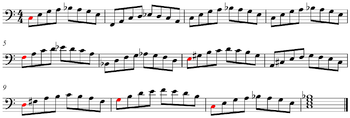Chord rewrite rules



In music, a rewrite rule is a recursive generative grammar, which creates a chord progression from another.
Steedman (1984)[1] has proposed a set of recursive "rewrite rules" which generate all well-formed transformations of jazz, basic I–IV–I–V–I twelve-bar blues chord sequences, and, slightly modified, non-twelve-bar blues I–IV–V sequences ("rhythm changes").
The original progression may be notated as follows (typical 12-bar blues):
1 2 3 4 5 6 7 8 9 10 11 12 I/ I/ I/ I// IV/IV/ I/ I// V/ IV/ I/ I
Where the numbers on the top line indicate each bar, one slash indicating a bar line and two indicating a phrase marking, and the Roman numerals indicating the chord function. Important transformations include
- replacement or substitution of a chord by its dominant or subdominant:
1 2 3 4 5 6 7 8 9 10 11 12 I/IV/I/I7//IV/VII7/III7/VI7//II7/V7/I/I//
- use of chromatic passing chords:
...7 8 9...
...III7/♭III7/II7...
- and chord alterations such as minor chords, diminished sevenths, etc.
Sequences by fourth, rather than fifth, include Jimi Hendrix's version of "Hey Joe" and Deep Purple's "Hush":
1 2 3 4 5 6 7 8 9 10 11 12 ♭VI, ♭III/♭VII, IV/I/I//♭VI, ♭III/♭VII, IV/I/I//♭VI, ♭III/♭VII, IV/I/I//
These often result in Aeolian harmony and lack perfect cadences (V–I). Middleton (1990)[2] suggests that both modal and fourth-oriented structures, rather than being, "distortions or surface transformations of Schenker's favoured V-I kernel, are more likely branches of a deeper principle, that of tonic/not-tonic differentiation."
For the ♭ notation, see Borrowed chord.
Sources
| ||||||||||||||||||||||||||||